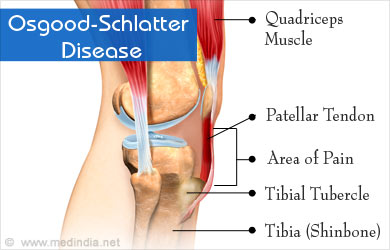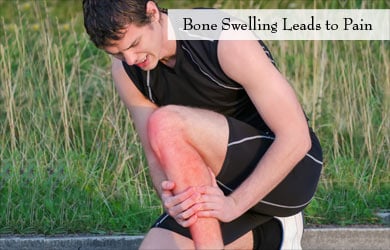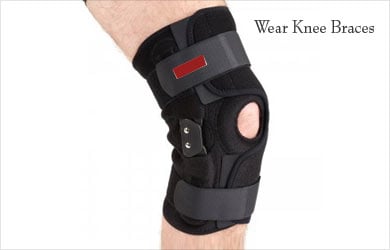- Knee Problems - (http://www.niams.nih.gov/health_info/knee_problems/#13)
What is Osgood-Schlatter Disease?
Osgood-Schlatter disease, also called apophysitis of the tibial tubercle, is a condition that causes knee pain. Children and adolescents are the ones commonly affected by this condition. It was described by two surgeons, Robert Osgood and Carl Schlatter, and is therefore named as Osgood-Schlatter disease or Osgood-Schlatter syndrome.
The knee is an important joint of the lower limb that connects the thigh bone and the main leg bone or the tibia. The tibia has a small prominence in the front on its upper aspect called the tibial tubercle. As with other bones, it is cartilaginous first, and then ossifies to form bone through a secondary center of ossification. It joins the tibia during adolescence. Such a type of bony projection of a main bone is called an apophysis.

The tibial tubercle gives attachment to the patellar tendon or patellar ligament. This tendon initially originates from the muscles of the front of the thigh called the quadriceps, which pull the bent knee straight. The lower end of the muscles form the quadriceps tendon which is attached to the upper end of the patella or kneecap. The tendon further extends downwards below the patella as the patellar tendon and gets attached to the tibial tubercle. Every time the knee has to be straightened, the quadriceps muscles shorten. This pulls up the patellar ligament, which in turn exerts a pull on the tibial tubercle.
What are the Causes of Osgood-Schlatter Disease?
Osgood-Schlatter disease is a condition characterized by inflammation of the tibial tubercle. Since the tubercle is an apophysis, the condition is called apophysitis of the tibial tubercle. The attached patellar tendon may also be involved.
Osgood-Schlatter disease occurs due to repeated bending and stretching of the knee joint, as in young athletes. The repeated movement creates traction and stress on the bone that has not yet completely ossified and fused to the main bone. The stress may cause micro fractures, which may heal with excess bone formation, resulting in the tibial tubercle becoming more prominent. The rapid growth noted in adolescents who are particularly affected at this age is also a likely contributing factor to the development of the condition.
What are the Symptoms of Osgood-Schlatter Disease?
Osgood-Schlatter disease usually affects boys, between the ages of 10 and 15 years during the growing period, who are usually involved in sports, though girls may also be affected. Symptoms of Osgood-Schlatter disease include the following:
- Pain at the lower aspect of the knee at the tibial tubercle
- The pain increases with activities like running, jumping and kneeling and reduces with rest
- The pain is present on applying pressure at the tibial tubercle
- The pain may recur, but it usually subsides once the bone is ossified
- A bony swelling may be felt, which is painful to touch

How is Osgood-Schlatter Disease Diagnosed?
Diagnosis of Osgood-Schlatter disease is based on history and physical examination of the patient. Ultrasonography helps identify this condition in the early stage. An x-ray may sometimes be taken to rule out any other condition that may produce similar symptoms.
How Do You Treat Osgood-Schlatter Disease?
Osgood-Schlatter disease usually subsides as the child or adolescent grows up and the bone gets fused, and therefore may not require any definitive treatment. Management is usually conservative and involves rest, application of ice and specific exercises. Anti-inflammatory drugs like NSAIDs, physiotherapy, techniques such as electrical stimulation are employed for control of inflammation and pain.
Short term measures that may be suggested include the following:
- Apply ice or icepack after activity to reduce the pain.
- Avoid vigorous exercise if the pain is severe. Alternate forms of sports may be advised that put less stress on the attachment of the patellar ligament.
- A physiotherapist may advise some stretching and strengthening exercises for the lower limb. These specifically help restore the flexibility and strength of the group of muscles called quadriceps and hamstrings.
- A knee brace may be necessary for those who would prefer to continue their activities.

People who have attained skeletal maturity may require surgical excision, but this is rarely indicated. Chronic cases that have failed to respond to other measures may benefit from surgery.
Health Tips
Adolescents should not be discouraged from sports for fear that they will suffer from Osgood-Schlatter disease. Stretching exercises are important before any athletic activity. This would reduce the stress on the tibial tubercle and help prevent development of Osgood-Schlatter disease.




